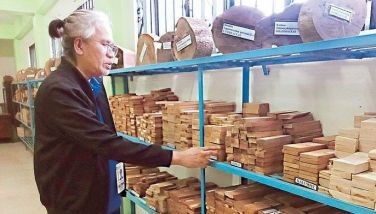Biodiversity in region endangered
MANILA, Philippines – The ASEAN Center for Biodiversity (ACB) yesterday called for intensified environment conservation in Southeast Asia, as it declared a “red alert” for the region’s rich biodiversity.
This, as the ACB described Southeast Asia’s rich biodiversity as “highly threatened” due to massive forest conversion and wildlife hunting and trade.
According to ACB executive director Rodrigo Fuentes, there will be massive species decline and extinction in Southeast Asia if governments would fail to strengthen further efforts to protect the environment.
He even warned that biodiversity in the region could spell tragedy for the world since Southeast Asia is the richest reservoir of plant and animal life on earth.
The ACB noted that the ASEAN region, while occupying only three percent of the earth’s surface, contains the natural habitats of up to 40 percent of all species on earth.
The region also has one-third or 84,000 square kilometers of all coral reefs.
However, the ACB also said that the region is home to seven of the world’s 25 biodiversity hotspots.
It pointed out that from the 64,800 known species, at least 1,300 are endangered, while 80 percent of its coral reefs are at risk due to destructive fishing practices and coral bleaching.
“Without a concerted effort to protect and conserve biodiversity, Southeast Asia’s 580 million people and the entire human race are in danger,” the ACB said.
Fuentes said loss of biodiversity in Southeast Asia could be primarily blamed on forest conversion in the region.
He said forest conversion is driven by large-scale deforestation for timber by commercial logging activities, shifting cultivation, large-scale mining, and agricultural expansion.
He said these lead to loss of habitat for many birds, mammals and other animals; reduced pollinator activity; decline in species richness and populations and overall reduction in biodiversity.
In Sumatra, for instance, there has been a decline from 80 to 33 percent, from 1980-2001, in forest cover within 50-kilometer periphery, the ACB said.
Meanwhile, the ACB said incidents of forest fires in the region in 1997-1998, 2002 and 2006, resulted in the population decline, and high infant and juvenile mortality in many animals, as well as reduced seedling and sapling population for many tree species.
“Biodiversity loss could trigger enormous effects on food security, health, shelter, medicine, and aesthetic and other life sustaining resources,” Fuentes also said.
Aside from forest conversion, the ACB said wildlife hunting and trade for food, pet, and medicinal purposes also contribute to biodiversity loss in the ASEAN region.
Overall, it said, wildlife was extracted from forests at more than six times the sustainable rate.
Moreover, the ACB said that increasing human population and poverty, climate change, and lack of financial resources likewise contributes to biodiversity loss.
On the other hand, the ACB said climate change could have the largest proportional effect on biodiversity in extreme environments (e.g., Arctic, boreal zones).
ACB data showed that in Sarawak, 2.6 million animals were hunted each year for bush meat while in Sabah, 108 million animals suffered the same fate.
The data further indicated that in 2000, Indonesia contributed about 29 percent of global exports for snake and lizard skins while Singapore imported 7,093 live animals and had a total net export of 301,905 animal skins in the same year.
From 1975 to 1992, Korea imported 6,128 kilograms of tiger bones, 60 percent of which were from Indonesia while in China, tigers, rhinos, turtles, snakes and monkeys continue to be major sources of traditional Chinese medicine, the ACB data added.
On the occasion of Earth Day tomorrow, the ACB appealed to international and regional organizations, governments, private corporations and foundations, communities and individuals to support its programs.
The ACB, with funding support from the European Union, is an intergovernmental regional center that facilitates cooperation and coordination among members of the Association of Southeast Asian Nations (ASEAN) on the conservation and sustainable use of the region’s already dwindling biodiversity resources.
So far, among the efforts taken by ASEAN member countries in order to foster and ensure conservation of the region’s biodiversity include its ratification of a number of international agreements with biodiversity concerns.
- Latest
- Trending






























